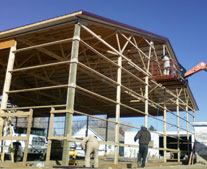How Are Funds Dispersed From a Construction Loan?
Reader CASSANDRA in ROXBORO writes:
“When applying for this construction loan as each job is done will the money be dispersed as each job is finished and inspected.? Do you know any in North Carolina that does the whole build or has turkey homes?”
Mike the Pole Barn Guru writes:
 Draw requests all start with a draw schedule. A construction loan draw schedule is a detailed payment plan for your construction project. These are typically split up into various milestones or overall project phases.
Draw requests all start with a draw schedule. A construction loan draw schedule is a detailed payment plan for your construction project. These are typically split up into various milestones or overall project phases.
With a draw schedule in place, an owner or project manager will submit a detailed report of work completed at certain points. This report should be substantiated by a bundle of various documents offered as work performed proof. If everything checks out, payment will be released. This bundle is commonly referred to as a draw request.
A draw request isn’t just a simple form. It’s a document bundle submitted to your lender requesting funds to be released. These documents are meant to provide clear evidence work has been completed and support costs associated with reaching a draw milestone.
Draw amounts are based on cost breakdown for each particular milestone. Documents required for each draw depends on your lender (and sometimes your state).
Critical inclusions in a draw request are invoices and receipts for work performed during draw period. These should be collected from all subs and suppliers before submitting a draw request as justification for funding. Whether for work performed, or materials purchased, they should be sufficiently detailed to justify a draw request. Having all your invoices properly organized before submitting them to your lender, can save them time reviewing request, and can get you paid more quickly!
A values schedule is a document listing all line-item tasks needed to be completed along with an estimated budget for each task. Each line item should be updated with each draw request. Tracking work through a values schedule helps keep track of how much money has been spent with regards to work completed to date amounts.
Change orders come up on just about every construction project. Anytime there is a modification or deletion to original construction plans; a change order will arise. Change orders will provide a detailed changes made description, and any additional time costs incurred by your contractor.
Lien waivers should be submitted along with every invoice. These will typically be conditional waivers since payment has not yet been made. Because a mechanics lien filing is the most prominent form of risk concerning lenders, a draw request will likely be postponed until all lien waivers have been submitted.
Finally, some overview or explanation of your job’s progress will typically be required. This might be as simple as identifying milestones reached or providing a checklist of itemized tasks needed to be completed to substantiate your draw request.
There’s not a substantial difference between draw requests and pay apps, but it is more than just semantics.
Payment applications are submitted to a customer as an invoice for performed work. Contractors and subs will submit payment apps to then be verified by owner or project manager, and ultimately submitted as a draw request.
Draw requests refer to bundle documents submitted to your lender in order to draw payment for work performed. Draw requests are usually made by an owner or project manager, made up by any number of pay apps and other supporting documents collected by prime contractor(s).
While both draw requests and payment applications feature similar documentation, these terms shouldn’t be confused. It is more accurate to refer to draw requests when exclusively discussing demands for payment from a lender. Conversely, when payment requests are submitted to some other party (like an owner or contractor), “payment application” is more appropriate.
Once a draw request has been submitted to your lender, their review process begins. Your lender needs to review all documents, order and approve inspections, and verify all work claimed to be completed, has been. This draw approval process ideally takes about seven business days. However, depending on size, complexity, and amount of draw request documents, this can take much longer.
When a lender has to request additional documentation or has to verify certain information as correct, payment is slowed down for everyone on your project – and it has a snowball effect. It takes time for payments to wind through payment chains. Funds must reach each chain link, and every time payment changes hands, there’s potential for additional delays. So, when submitting construction draw requests, it’s essential to have all information accounted for and organized. Streamlining your lender’s release of payment means streamlining payments for even construction payment chain’s lowest tiers.
You may want to give strong consideration to acting as your own General Contractor:
https://www.hansenpolebuildings.com/2020/02/does-my-barndominium-need-a-turn-key-general-contractor/
https://www.hansenpolebuildings.com/2019/11/a-contractor-for-your-new-barndominium/
https://www.hansenpolebuildings.com/2019/11/a-contractor-for-your-barndominium-part-ii/
https://www.hansenpolebuildings.com/2019/11/a-contractor-for-your-barndominium-part-iii/
 TRANSPORTATION/SHIPMENT:
TRANSPORTATION/SHIPMENT: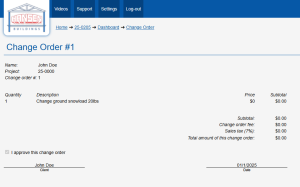 CHANGE ORDERS:
CHANGE ORDERS: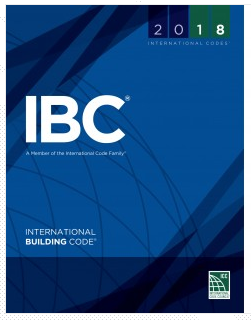 BUILDING CODES:
BUILDING CODES: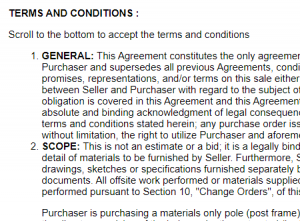 Chances are good Purchaser is going to be having conversations with multiple possible providers prior to picking one. Seller might very well have hundreds (or even thousands) of clients they are interacting with. All of these back-and-forths lend themselves to a great deal of possible confusion. In order to protect all parties involved (and should there be no equitable resolution and it ends up in court), if it is not in writing, it does not exist.
Chances are good Purchaser is going to be having conversations with multiple possible providers prior to picking one. Seller might very well have hundreds (or even thousands) of clients they are interacting with. All of these back-and-forths lend themselves to a great deal of possible confusion. In order to protect all parties involved (and should there be no equitable resolution and it ends up in court), if it is not in writing, it does not exist. 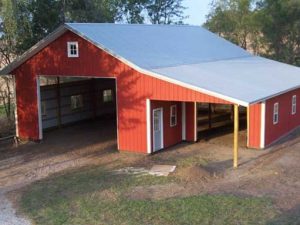 Now how can we do this? We have developed proprietary software which does all of the structural design, calculates the needed materials and even issues purchase orders and shipping information. It is pretty much all automated ….. so when you decide to make a change after the fact, all of the wheels of progress need to come to a screeching halt.
Now how can we do this? We have developed proprietary software which does all of the structural design, calculates the needed materials and even issues purchase orders and shipping information. It is pretty much all automated ….. so when you decide to make a change after the fact, all of the wheels of progress need to come to a screeching halt.